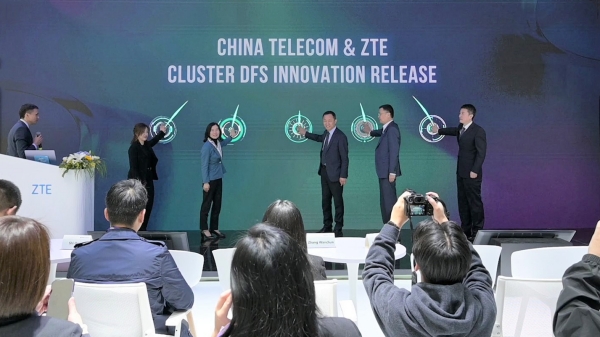ZTE and China Telecom unveil 5G-Advanced solution for B2B and B2C services
ZTE, in partnership with China Telecom, has released a 5G-Advanced solution, named Cluster DFS at Mobile World Congress 2023 in Barcelona, Spain. According to ZTE, the new offering will facilitate the development of specific B2B and B2C services using a single 5G network.
China Telecom claims to have deployed the world’s largest 5G SA network with more than 1 million 5G base stations based on a RAN-sharing strategy. The Chinese carrier noted it continues to focus in the B2B segment, with the number of private 5G networks hitting over 3,000, and commercial projects in this segment totaling 9,000 by the end of 2022.

Image Credit: ZTE
ZTE explained that that the new solution will be key as the service-level agreements (SLAs) requirements for the provision of 5G for industrial verticals such as smart manufacturing or smart grid are different from the requirements for the provision of 5G services for consumers. ZTE further explained that it launched the new solution given to the increasing complexity of 5G networks and to enable a coordinated development of B2B and B2C services on a single network and deliver differentiated service experiences.
To adapt to vertical application traffic dynamics on uplink and downlink, China Telecom and ZTE have introduced the innovative Cluster DFS, by which, base stations with same heavy uplink characteristics are intelligently formed as “cluster” to implement accurate adaptation between frame structure and services requirements. Consequently, a 5G network can synergize B2B and B2C services with optimal user experiences.
Li Peng, Director of Network Development and Sharing Department of China Telecom, said, “5G has become an important driving force of digital economy development. China Telecom is continuously exploring and promoting innovative technologies and solutions that combine the development of 5G high-quality networks and industrial applications.”
“Based on previous successful experience of Cluster DSS, China Telecom further extends ‘cluster-level’ radio resource management mechanism from ‘frequency domain’ to ‘time domain’, which provides more flexible radio resource strategy and promotes the development of fully-connected factories. The commercial trial of Lierda shows that Cluster DFS has increased the uplink throughput of B2B applications by 60~80% while ensuring stable B2C experiences, significantly improving network performance and efficiency, ” added Huang Lilian.
Tang Xue, VP of RAN Products, said, “B2B and B2C coordinated development on one network requires more flexible and more intelligent resource management strategy, therefore, RAN intelligence is of great importance. ZTE uses RAN native-AI to enable adaptive radio resource adjustment, including spectrum, frame structure, power and beams. With four key features, specifically, intelligent traffic prediction, cluster self-generating, intra-cluster traffic shaping and inter-cluster coordination, the potential of commercial 5G networks can be fully unlocked to offer optimal experiences for both industrial applications and consumer users.”
Cluster DFS provides precise and on-demand user experiences for both consumers and enterprises based on AI capability, enabling network policy shift from “one-size-fit-all” to “context-aware” and coordinating the development of B2B and B2C on 5G commercial networks.
Moving forward, ZTE and China Telecom will continue working together to carry out innovative practices and facilitate the development of 5G-Advanced applications for a digital, intelligent and green future.
ZTE said Cluster DFS provides precise on-demand user experiences for consumers and enterprises based on its AI capability to coordinate the development of B2B and B2C on 5G commercial networks.
China Telecom and rival network operator China Unicom had previously signed an agreement to co-build and co-share their 5G networks. According to the latest available statistics, China Telecom added a total of 5 million 5G subscribers during the first months of the year to take its total 5G subscribers base to 273 million. During 2022, the telco added a total of 80.16 million 5G subscribers.
References:
https://www.zte.com.cn/global/about/news/china-telecom-and-zte-release-cluster-dfs-at-mwc-2023.html
https://www.zte.com.cn/global/about/news/20220526e2.html


